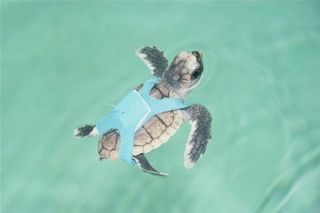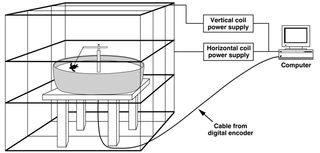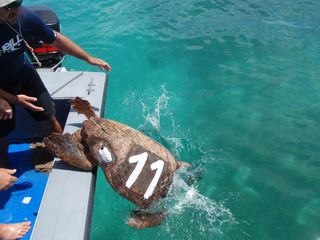Loggerhead Turtle Migration Follows Magnetic Map

This Behind the Scenes article was provided to LiveScience in partnership with the National Science Foundation.
Nesting season for loggerhead turtles — a threatened species — is in full swing on the sandy beaches between Florida and North Carolina. Nesting began this year in the first days of April, several weeks earlier than usual — possibly because of the relative warmth of coastal waters in the wake of the mild winter. The early kick-off of the loggerhead nesting season may portend a record number of nests by August, when nesting typically ends.
During nesting season, adult female loggerheads, some weighing as much as 300 pounds, leave the sea at night and lumber onto the beach. Then, mustering their might, the turtles use their rear flippers to dig a shallow pit in the sand — a protective cavity where the eggs will incubate.
After each lays approximately 100 eggs, the turtles cover their nests with sand and trudge back to the sea, never to see their offspring. Warmed by the sun, loggerhead eggs hatch about 50 to 60 days later, with most baby turtles emerging sometime between June and September.
Finding Their Way In the World

Immediately upon leaving its nest, each hatchling will scramble to the ocean and began an epic 8,000-mile solo journey around the North Atlantic basin. Young loggerheads that survive this incredible migration will return to the coastal waters of North America in about 6 to 12 years — only after they have grown too large to be eaten by most types of predatory fish and birds that populate coastal waters. (Adult loggerheads are distinguished by their huge heads and large crushing jaws.)
The migrations of young loggerhead turtles take them into the relative safety of the open ocean where predators are less abundant than in coastal waters. The journey is among the longest and most spectacular migrations in the animal kingdom. The turtles begin as utterly defenseless, two-inch-long hatchlings — the odds stacked heavily against them.
Sign up for the Live Science daily newsletter now
Get the world’s most fascinating discoveries delivered straight to your inbox.
Able to swim at maximum speeds of only about half a mile an hour, and unable to dive, young turtles slowly swimming along the ocean’s surface can’t evade most predators. Most do not survive. Only about one in 4,000 Florida hatchlings reaches adulthood.
Survival Strategies
The extreme vulnerability of loggerhead hatchlings to predators and the whims of wild oceans begs the question: How do any of these animals survive their marathon migrations?
Surprising new answers come from a research team led by Kenneth Lohmann, a marine biologist at the University of North Carolina at Chapel Hill who is partially funded by the National Science Foundation. According to the team’s latest findings, which were published in two recent companion papers, loggerhead turtles are born with an inherited "magnetic map."
The Earth’s magnetic field varies across the globe; slightly different fields exist in different geographic regions. As they encounter magnetic fields at specific locations along the migratory route, the turtles’ magnetic map — a series of inherited instructions — tell young turtles which way to go. The magnetic map allows young turtles, as Lohmann puts it, to use these different fields as "road signs in the open sea." Differences in magnetic fields at different locations cause the turtles to change swimming directions so that they stay on course along their migratory pathway.
For example, young loggerheads respond to a particular magnetic field near northern Portugal by turning south. This response helps them stay in warm waters and avoid being swept north into frigid waters near Great Britain and Scandinavia, where they would probably freeze to death.

Lohmann’s team studied the magnetic map of the loggerhead turtles through laboratory experiments that involved exposing young turtles that had never before been in the ocean to magnetic fields like those at key locations along their migratory route. For example, in one experiment they exposed loggerheads hatched in south Florida to magnetic fields they would encounter off Florida, Portugal and Africa. Most of the turtles made the same steering decisions that wild turtles make as they follow their circular route around the Atlantic. The results imply that the turtles’ brains are hard-wired from birth to navigate their migratory routes.
In addition, Lohmann’s group found that turtles obtain both latitude and longitude-like information from the magnetic fields. In fact, turtles obtain much more complex spatial representations from magnetic fields than people obtain from their compasses
Smart Swimming
The researchers’ findings also suggest that, while using magnetic fields for navigation, the turtles make headway through a strategy of "smart swimming." This technique involves using strategic directional swimming — in areas where currents might otherwise carry the turtles off course — interspersed with passive drifting on currents moving in the direction the turtles want to go. Smart swimming enables turtles to conserve energy while migrating vast distances.
"The new results," Lohmann said, "tell us that a surprisingly small amount of directional swimming, performed in just the right places, has a profound effect on the migratory paths that turtles follow and on whether they reach habitats favorable for survival."
The concept of smart swimming grew out of extensive computer simulations combining ocean currents and "virtual turtles" that either drifted passively or swam for periods of one, two or three hours each day. Analyses revealed that even small amounts of swimming had a disproportionately large effect on the migratory pathway that the turtles followed.

These results are surprising because many scientists had thought that turtles couldn’t control their migratory paths because ocean currents in some places move so fast. "Contrary to expectations, our analysis shows that even the youngest turtles can influence their migratory path enough to affect the likelihood of survival," Lohmann said.
The team’s results suggest that other slow-moving creatures — including butterflies, ballooning spiderlings and larvae of commercially important fish and crab — may also exert more control over their movements than previously believed.
Future Studies & Conservation
The researchers will continue their loggerhead studies by collaborating with other scientists who are tracking young turtles through the ocean using satellite transmitters. The team will monitor the paths of the turtles as they migrate, and then determine how much of their movements are attributable to active swimming and how much to passive drifting.
All species of sea turtles are threatened or endangered. Fortunately, Lohmann’s discoveries about the loggerhead’s use of the Earth’s magnetic field for navigation may help improve some sea turtle conservation strategies.
A case in point: In Florida and elsewhere, a common conservation practice is to surround turtle nests on the beach with wire cages to protect the turtle eggs from predatory beach raccoons. Well-meaning though the use of such cages may be, they may distort the local magnetic field and thereby compromise the ability of hatchlings to navigate after they leave their nests.
Editor's Note: The researchers depicted in Behind the Scenes articles have been supported by the National Science Foundation, the federal agency charged with funding basic research and education across all fields of science and engineering. Any opinions, findings, and conclusions or recommendations expressed in this material are those of the author and do not necessarily reflect the views of the National Science Foundation. See the Behind the Scenes Archive.

